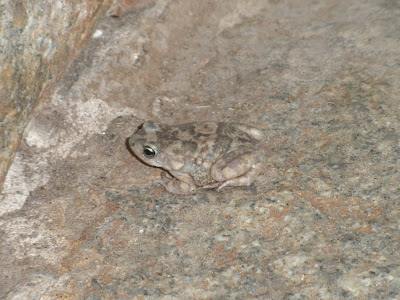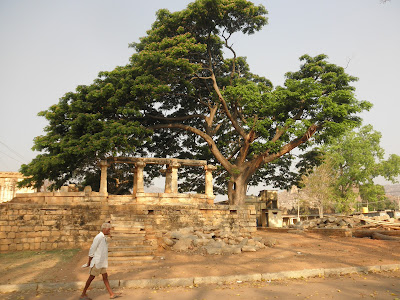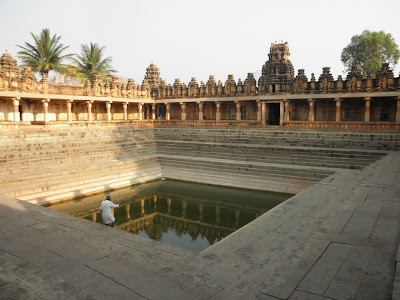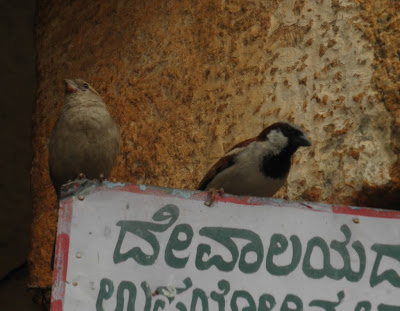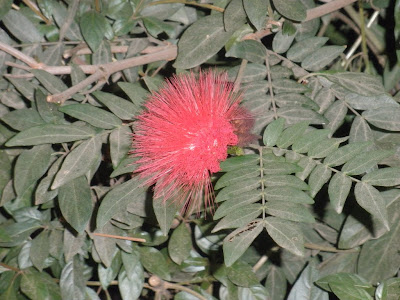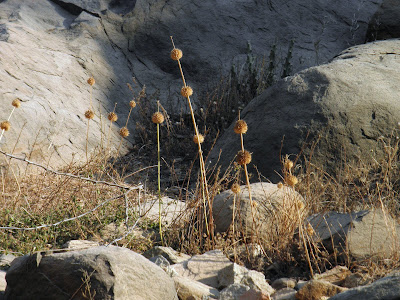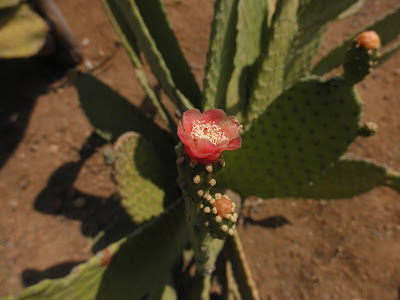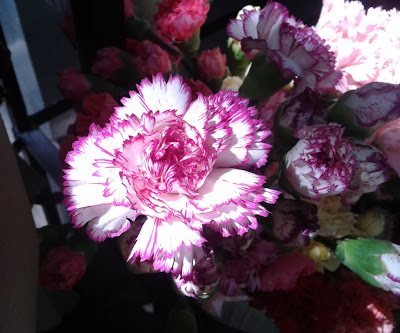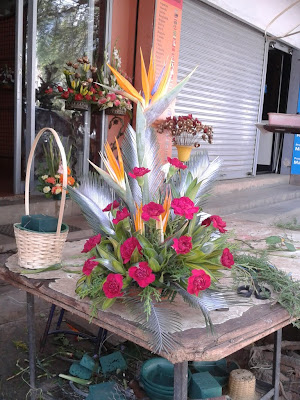A couple of weekends back I ventured to the National Gallery of Modern Art, on palace road. What drew me to the place was not just the paintings but a recent writeup in the newspaper of the gardens around the gallery and the many trees it housed.
Indeed it lived up to the article - the NGMA is housed in what was previously called the Manikyavelu Mansion - Over 90 years old, the Manikyavelu Mansion was owned by the royal family of Mysore. The mansion later came to be owned by Raja Manikayavalu Mudaliar, a mine owner. It was taken over by the State Government in the late sixties, who then offered it to the Ministry of Culture in July 1989 for setting up of a modern art Museum at Bengaluru by NGMA.
Spread over 3.5 acres the grounds of the mansion have many really old trees - and to help you find your way and name the trees the Gallery has a booklet that is a 'tree map' with the name and location of each tree. All thanks to the efforts of Prashanta Bhat and Behula Shah.
Friday, March 30, 2012
Wednesday, March 28, 2012
Flowers along the way
The temple tour provided an opportunity to capture many trees and flowers.
First the ubiquitous jasmine.
The erecta duranta, but a variety different from what we see in the city, as the leaves had a yellow lining to them.
First the ubiquitous jasmine.
The erecta duranta, but a variety different from what we see in the city, as the leaves had a yellow lining to them.
A sausage tree, just done blooming, at the Lepakshi temple.
Tuesday, March 27, 2012
Temple Trees - Lepakshi
The town of Lepakshi in Andhra Pradesh is renowned for its beautiful temples - the main Lepakshi temple is a treasure trove of 16th century Vijaynagar empire art and architecture. The sculpture on the pillars and walls and the paintings on the ceiling were breathtaking.
So of course were the trees.
This bright red shoe flower was at the Rangansthala temple, on the way back from Lepakshi.
So of course were the trees.
This bright red shoe flower was at the Rangansthala temple, on the way back from Lepakshi.
At the Lepakshi temple I also encountered what I believe is the best example of camouflage that I have ever seen - a toad blending perfectly into the stone steps of the temple.
Monday, March 26, 2012
Of temple trees and tanks - The Bhoganandishwara Temple
A recent trip acquainted me with some of the temples of Karnataka and neighboring Andhra Pradesh. As always the older they were , the more they appealed to my aesthetic sense and spiritual sensibilities.
The Bhogandishwara temple, built in 810 A.D by the Cholas. The area around the temple is very well maintained by the Architectural Society of India.
The interior was just as impressive. There were three sections - one with the prayer hall and inner sanctum, another with the kalyana mandapam (wedding hall) and a third - the most spectacular - a huge tank area surrounded by the most exquisite sculpture.
And in the tank area I saw something I had not seen for many many years - the house sparrow! Driven away from the cities by the rapid urbanization, loss of nesting space and feed, it seems they are still prevalent in the rural areas, specially places like this temple where the priests scatter seeds around for them every day.
We also saw, what I think is the Indian pond heron near the tank outside.
Sunday, March 25, 2012
The colors of March
While I have admired the colors around this Spring, I have not taken pictures. So rather than share photographs, I can only write about the delicate pinks and whites of the trumpet tree that bloomed all over Indiranagar and greeted me each morning as I drove over the Domlur flyover; The striking red of the tree that is on the 12th main, the yellows of the carribbean trumpet tree in the park near Old Madras Road and the ethereal lilac/purple of the jacaranda all over the city. It has been an absolute delight looking at these trees and reveling in their midst. The raintree right in front of my house has also bloomed, the picture below though is from the one at the Bhoganandishwara temple that I visited a few days back.
The gulmohars in the city have not started blooming yet, they usually wait until April - but this one a little outside was in a riot of color, thanks due probably to the scorching heat.
And finally, the plumeria (near Bangalore Central Mall), showing off its sweet pink flowers.
The gulmohars in the city have not started blooming yet, they usually wait until April - but this one a little outside was in a riot of color, thanks due probably to the scorching heat.
And finally, the plumeria (near Bangalore Central Mall), showing off its sweet pink flowers.
Saturday, March 24, 2012
The Neem & the False Ashoka
Can you imagine there was a time when I was not able to differentiate the neem and the false ashoka trees? Of course the way they grew and branched was very different and could be used to tell them apart, but their leaves seemed oh so similar to me. With time I realized the false ashoka has darker and longer leaves, and of course that was about when I realized it wasn't the 'ashoka' but really was the mast tree.
But what still continued to be a mystery was the flowers of both these trees. I did manage to see both, on separate occasions some years back, you'll probably find them in the 2009 chronicles of this blog. But this year is when I've been able to see them both, within a few days of each other. Now i know that while the flowers of the neem are a pale white and have a protrusion in the middle (a style? a stigma?) those of the mast tree are a light green. They are both really tiny though, very delicate looking and both prefer the end of March or early April to appear.
Here you are, the mast tree in bloom at the National Gallery of Modern Art, Bangalore.
And the neem in bloom at a Jain Temple on the outskirts of Bangalore.
But what still continued to be a mystery was the flowers of both these trees. I did manage to see both, on separate occasions some years back, you'll probably find them in the 2009 chronicles of this blog. But this year is when I've been able to see them both, within a few days of each other. Now i know that while the flowers of the neem are a pale white and have a protrusion in the middle (a style? a stigma?) those of the mast tree are a light green. They are both really tiny though, very delicate looking and both prefer the end of March or early April to appear.
Here you are, the mast tree in bloom at the National Gallery of Modern Art, Bangalore.
And the neem in bloom at a Jain Temple on the outskirts of Bangalore.
A walk in the neighbourhood
Every now and then my mother notices some unusual plants and trees while on her walks around the neighbourhood and then takes me along.
The first tree that we looked at was the Datura suaveolens - Angels Trumpet. Beautiful white flowers hung all over the tree.
And finally the garden we've admired for the last two years.. above all for the beautiful bougainvillea above the portico and the mysore clock vine (Thunbergia mysorensis) hanging in the car park.
We passed many beautiful flowers as well.. here are some.
The red ginger (Alpinia purpurata)
A powderpuff (caliandra) variety
The first tree that we looked at was the Datura suaveolens - Angels Trumpet. Beautiful white flowers hung all over the tree.
This house had interesting looking flowers that resembled the bougainvillea but were not quite the same.
This one of course deserves a mention for how the house has been built around the coconut tree. If only everyone would care so much about the trees.
We passed many beautiful flowers as well.. here are some.
The red ginger (Alpinia purpurata)
A powderpuff (caliandra) variety
Friday, March 16, 2012
Hampi -- of trees, flowers and birds
Hampi is a spectacular place to visit, a veritable treasure for lovers of architecture and history. While I have tons of pictures of the architectural wonders of the place, here i'll share only the nature related ones.
Temple trees were of course, in plenty. This one was at the wonderful Vittala complex.
The landscape was rocky and arid, but that did not stop the locals from growing sugarcane. The resort we stayed at was set amidst sugarcane fields, lined with coconut trees and all enclosed by huge boulders. It was quite a site.
The lions ear (leonotis nepetiifolia) - common on roadsides and in degraded land.
and this is from near the Krishna temple.
And finally, this pretty little flower was everywhere..
Temple trees were of course, in plenty. This one was at the wonderful Vittala complex.
The landscape was rocky and arid, but that did not stop the locals from growing sugarcane. The resort we stayed at was set amidst sugarcane fields, lined with coconut trees and all enclosed by huge boulders. It was quite a site.
There were many banana plantations as well. One of the places we had dinner at , the Mango Tree , was in fact set within a banana plantation.
The rest of the area was dry and arid. Cacti like succulent plants were everywhere. This is from the area leading up to the Vittala complex.
The lions ear (leonotis nepetiifolia) - common on roadsides and in degraded land.
and this is from near the Krishna temple.
And finally, this pretty little flower was everywhere..
And this bird was around the pushkarni tank at the Vittala complex.
Friday, March 9, 2012
Subscribe to:
Posts (Atom)










